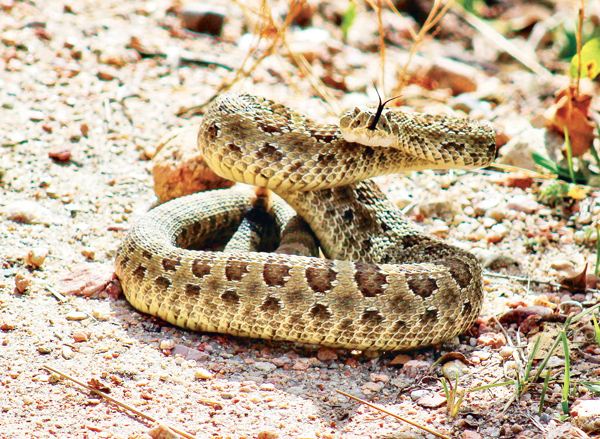Rattlesnake awareness and response
Reprinted from July 2016 issue

This western rattlesnake, photographed alongside a walking path at Castlewood Canyon State Park in Franktown, is common throughout Colorado. It has a shovel-shaped head, diamond back pattern with rattles on the tail, and is camouflaged by its environment.
As you go outside this summer for a hike, bike ride or even a stroll in your yard, be aware that rattlesnakes may be in the vicinity. The western rattlesnake (pictured above) and massasauga rattlesnake are the only two venomous snakes among the 25 species of snakes in Colorado. The western rattlesnake, ranging from one foot to five feet in length, appears in most habitats throughout the state. The smaller massasauga rattlesnake, ranging from one foot to three feet in length, however, is limited to the southeastern grasslands.
How to spot a rattlesnake:
According to Colorado State University Extension, there are several basic characteristics of these two venomous snakes: rattles at the end of the tail; fangs in addition to their rows of teeth; facial pits between the nostrils and eyes; vertical and elliptical pupils that may look like thin lines in bright light (non-venomous snakes have round pupils); and a broad triangular head and narrow neck.
Prevention at home:
Eliminate cool, damp areas where snakes hide. Remove brush and rock piles, move shrubbery away from foundations, and cut tall grass. Control insects and rodents (a snake’s primary food source) to force snakes to seek food elsewhere. Keep pet food, birdseed, etc. in closed containers. Seal any exterior cracks or openings 1/4” or larger with mortar or caulk.
Prevention while hiking or biking:
Be watchful and learn how to recognize a rattlesnake. Wear long, loose pants and leather hiking boots. Rattlesnakes are generally non-aggressive unless startled, cornered or stepped on. Alert rattlesnakes by sweeping grassy areas with a long walking stick before entering them. Never jump over logs, turn over rocks, put your hands in rock crevices, or sit down without first carefully checking for snakes. Rattlesnakes do not always shake their rattles before striking, so do not rely solely on your sense of hearing. If you encounter a rattlesnake, remain calm and still at first, then try to back away slowly and carefully.
If you are bitten by a rattlesnake:
Rocky Mountain Poison and Drug Safety recommends the following:
Remain calm – panicking will increase your heart rate and cause the venom to circulate more quickly. Venomous snakes do not always release venom when they bite. Do not try to kill the snake, but carefully move to a safe location.
Immediately check the injured area. If it is a venomous bite, there may be one or two visible fang marks in addition to teeth marks. Common reactions to venom are swelling and pain in the bite area, black and blue discoloration of the tissue, and possibly nausea. Painful swelling of lymph nodes in the groin or armpit usually occurs within one hour if the bite is on the leg or arm.
Immediately remove any clothing, jewelry, etc. in the area of the bite. If possible, wash the wound with soap and water. Immobilize the bite area, keeping it in a neutral or below the heart position. Get to a hospital immediately; if possible, have another person drive, and call ahead to alert ER staff.
Do not use a tourniquet. Do not make an incision at the bite site. Do not suck out the venom with your mouth, as this may increase the risk of infection. Do not use ice.
Emergency room treatment and prognosis:
According to Sky Ridge Medical Center’s emergency department, snake bite victims will receive treatment for symptoms, pain management, lab work, cardiac analysis/monitoring, and (when indicated) the administration of a tetanus injection, antibiotics and anti-venom. Allergic reactions to anti-venom are possible, and patients requiring treatment will be monitored for such a reaction. If monitoring and testing reveal no significant findings, most patients will be discharged to go home. Admission to the hospital may be required for those patients needing further monitoring, treatment and medical observation.
What to do with a rattlesnake:
You may contact the Douglas County Sheriff’s Office and they will dispatch a deputy to your location to deal with a rattlesnake. However, according to the Colorado Division of Wildlife, it is legal to kill rattlesnakes when necessary to protect life or property – if done in accordance with city and county ordinances. Call your local police department or animal control services for details.
The most common method to kill a rattlesnake is clubbing or shooting. If you kill a rattlesnake, wear gloves and use a shovel to cut off the head, and bury it and the body. Do not touch the head of a dead rattlesnake. Even if it has been decapitated, as it can still bite and inject venom. This occurs because the snake’s heat sensory pits are active until rigor mortis is complete. Therefore, placing a warm object, such as a hand, near the snake’s mouth will trigger a biting response.
For additional information, contact Rocky Mountain Poison & Drug Safety at 800-222-1222 or 303-389-1100 or the Douglas County Sheriff’s Office (non-emergency) at 303-660-7505. If you are bitten by a rattlesnake, seek medical attention immediately or call 911.